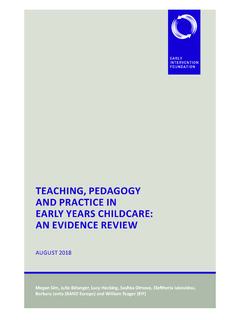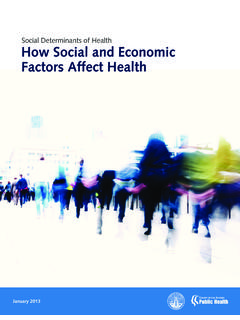Transcription of The impact of recent government policies on early years ...
1 The impact of recent government policies on early years provision _____ Avinash Akhal, Researcher, Social Mobility and Vulnerable Learners January 2019 Research Area: Eary years Development 2 Introduction The early years sector has undergone a number of policy changes in recent years , primarily in the form of subsidies and tax relief initiatives to help parents with the cost of childcare (see Figure ). In 2015, the government introduced the early years Pupil Premium which targeted additional funding of 300 to providers for each child from a disadvantaged background that meets the eligibility Additionally, in 2016, Universal Credit expanded to support up to 85 per cent of childcare costs, up from 70 per cent, and is gradually replacing the childcare component of the working tax In April 2017, the government introduced a tax-free childcare scheme to replace childcare vouchers and then rolled out the 30 hours entitlement policy in September 2017.
2 The entitlements are funded through 6bn in childcare spending per year until 2020, of which 1bn per year will be used to support delivery of the 30 hours Figure Policy changes affecting the early years sector since 1998 Date Policy September 1998 Introduced hours free education for all 4- year olds for 33 weeks per year April 2004 Entitlement extended to 3- year olds April 2005 Entitlement increased to 38 weeks September 2009 Introduced 10 hours per week for most disadvantaged 2- year olds for 33 weeks September 2010 All offers extended to 15 hours per week for 38 weeks (spread over 3-5 days) September 2012 Entitlement spread increased to 2-5 days September 2013 Extended funded places to 20% of most disadvantaged 2- year olds September 2014 Extended funded places to 40% of most disadvantaged 2- year olds April 2015 early years Pupil Premium introduced April 2016 expanded childcare component of Universal Credit April 2017 Tax-Free childcare introduced September 2017 Introduced 30 hours entitlement for working parents October 2018 Childcare Vouchers scheme ends It is important to understand the impact of government policy on the early years sector due to its pivotal influence on child development and parental employment.
3 Several studies have highlighted large socio-economic returns to investments in early years education. Economist James Heckman found that investing in early years yields the highest returns to society in comparison to interventions at other life stages; he claimed each dollar invested returns $13 per Other studies have also found a positive relationship between spending on early years and economic and educational outcomes, particularly for disadvantaged The Education Policy Institute recently submitted evidence to the Education Select Committee life chances inquiry which summarised the key evidence in this area and highlighted the importance of the early years on a child s future cognitive, emotional and social 3 This report examines the impact of recent policy changes on take-up of different childcare entitlement groups and on the total number of funded places.
4 In particular, we are interested in whether changes to entitlements have resulted in some groups being prioritised over others. Key findings We found a possible trade-off in provision between the take-up of the entitlement for disadvantaged two- year olds and take-up of the 30 hours entitlement for three- and four- year olds. There is wide variation across local authorities; in some authorities where take-up of the 30 hours entitlement has increased, there has been a decrease or slowing down of take-up of the two- year old entitlement. In others, there has been an increase or acceleration of take-up amongst disadvantaged 2- year olds. The differences in delivery costs for two- year -olds and three- and four- year olds could explain the decision of some local authorities to prioritise places.
5 There was no clear relationship between the take-up of the 30 hours entitlement and the change in the supply of places. The data shows that, despite local authorities having similar levels of take-up, there were still wide variations in the change in the number of funded places. This indicates that the 30 hours policy does not clearly stimulate new capacity in the short term, but the full effect may yet to be seen. There was no evidence that changes to funding rates have had an impact on the take-up of the 15 hours or the 30 hours entitlements in the short run. It is possible that increases in funding may have been absorbed by existing funding pressures. i Additionally, it may be possible that other variables may have a stronger influence on early years take-up, such as parental work patterns, the relative cost of childcare and the perceived benefits of childcare.
6 Part 1. early years policies In September 2017, the government announced that working parents would be entitled to 30 hours of free childcare, building on the existing 15 hours free entitlement. The policy is intended to provide further subsidies for working parents and those seeking to (re)enter the labour market. Parents need to earn the equivalent of 16 hours on national minimum wage and have a salary below 100,000 to be The entitlement is accessed by requesting a code from the government childcare service, which then needs to be validated through the eligibility checking system. Funding then comes into effect after the code has been validated and in the term following a child's third Parents are then required to reconfirm their eligibility code every three months for continuous access to the entitlement.
7 This analysis uses data from the Department for Education on the number of validated eligibility codes since September 2017 as a proxy for the take-up of the 30 hours entitlement. Throughout this report the term take-up of 30 hours is used instead of validated codes . During the academic year , the number of children on the 30 hours entitlement increased as more children turned three (see Figure ).9 The dip from May 2018 corresponds to maintained nursery schools not being open i The early years independent sector research programme from CEEDA found a 616m funding gap for private, voluntary and independent nurseries and pre-schools in 2018/19. 4 and some private, voluntary and independent (PVI) nurseries not offering a stretched entitlement over the summer term.
8 Therefore, we use figures from May 2018 as these represent months of highest take-up for the 30 hours entitlement. Figure Number of 30 hours codes validated in England between September 2017 and September 2018 The implementation of the 30 hours policy coincided with the introduction of a new early years national funding formula (EYNFF), which aimed to be a fairer mechanism of funding local authorities and The formula determines how much funding is allocated from central government to local authorities and then from local authorities to early years providers. The first channel comprises three components to calculate how much funding is allocated to local authorities. These are the universal base rate; funding for additional needs; and an area cost adjustment to reflect the regional cost We focus on local authority rates to explore what influence funding has had on the change in take-up for two- year olds, three- and four- year olds and children on the 30 hours entitlement.
9 A note on the data We use data for Ofsted registered places instead of providers because the classification of providers has changed over time, making it increasingly inaccurate to compare data across The Ofsted early years register data for places contains an overlap of settings registered on both the early years register (EYR) and the childcare register (CR), therefore providers that accommodate children above five years old may be included. Consequently, our data might be overestimating the total number of places. In 2016, the government provided supplementary financial support to local authorities through a 100m early years capital The fund aimed to support the delivery of the 30 hours entitlement and gave priority to the local authorities that had the highest number or percentage of eligible children, the highest take-up rates and where providers were working close to full The fund may impact the number of places and take-up; however, it was not included in the analysis due ii Prior to 2015, childminder agencies were registered as individual providers, despite holding a network of registered childminders.
10 This means if the number of registered providers fell, it might reflect childminders joining an agency, rather than leaving the sector. 050,000100,000150,000200,000250,000300,0 00350,000400,000 Number of validated codes5 to the lack of public information on project awards and completion dates. As a result, we could not accurately analyse the impact of the early year s capital fund. Part 2. Analysis This section analyses the data for the 30 hours entitlement and the change in funding levels between 2016 and 2018. We begin by exploring the relationship between the 30 hours policy and the take-up of two- year olds, three- and four- year olds on the 15 hours entitlement and the total number of funded places.









